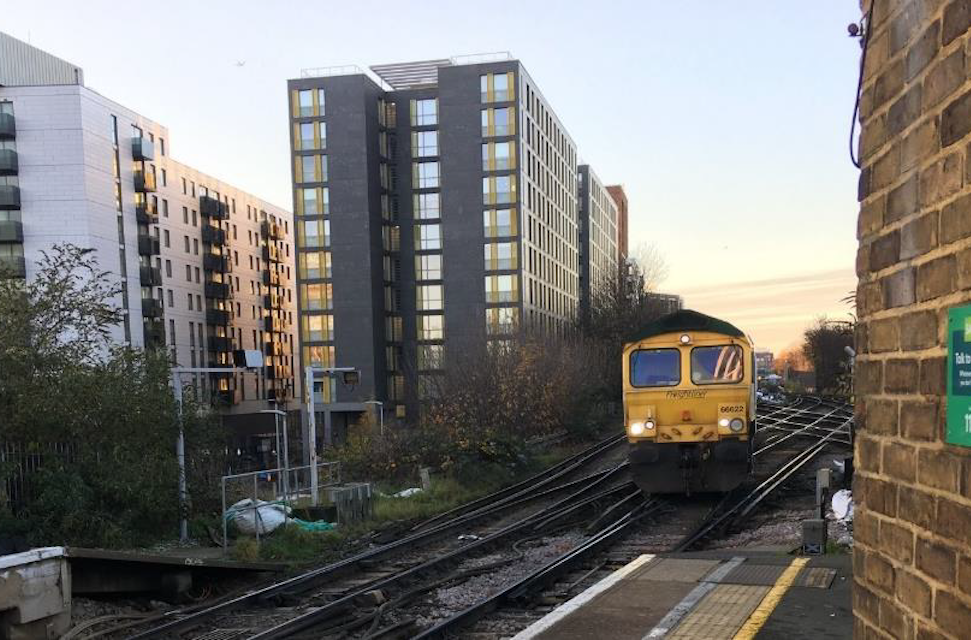London can’t lose with enhanced rail freight says politician

Putting more freight on the rails around the UK capital makes perfect sense, says politician Caroline Pidgeon. She should know what she’s talking about. Pidgeon is deputy chair of the London Assembly Transport Committee, a former mayoral candidate, and a keen promoter of rail freight. She recently wrote an open essay, putting forward her views on the advantages for the congested capital city. With a radical extension on the horizon for London’s Ultra Low Emissions Zone (ULEZ), covering the whole metropolitan area, a rethink of rail freight is a timely intervention.
London is not short of rail freight development, but there is plenty of scope for more operation, especially in the domestic and city-wide use of rail. That’s the belief of politician and transport advocate, Caroline Pidgeon. She says rail freight serves a critical but often-forgotten function for the capital, including providing a clean alternative to road logistics. There are plenty more opportunities, just around the corner, she says.
Marvelling at the successes of rail freight transportation
In addition to transporting commuters and travellers, London’s rail network is a critical component of the city’s freight infrastructure. Rail freight plays a vital role in supporting major construction projects, such as the Thames Tideway Tunnel, a vast upgrade of the city’s Victorian sewer system, and HS2, the equally vast high speed railway project which has been creating something of a stink all of its own. Rail has been a vital part of projects like those by transporting materials and removing spoilage in quantities that would leave the roads of London. The number of eager proposals (some already realised) for express logistics, which would move light goods brought in by rail to major London terminus stations, would provide the capital with a historical throwback, and also a modern, efficient and sustainable mode of goods transportation.
“Londoners, admittedly, don’t spend their days marvelling at the successes of rail freight transportation”, says Caroline Pidgeon, saying residents and visitors alike tend to seek out the globally recognised landmarks that pepper the city streets. Nevertheless, she argues that rail freight makes much of their daily life possible. “As well as serving daily commuters and people looking for weekend getaways, London’s rail network has an important role supporting the construction of such major infrastructure projects, carrying waste from urban areas for conversion into renewable energy and moving containerised consumer products through London and across Britain.”
Driving modal shift towards low-carbon freight
Transport for London’s freight action plan, published a few years ago but still a current policy, aims to cut the number of trucks and vans entering central London in the morning peak by ten per cent by 2026. Rail freight, along with other green logistics solutions, says the agency, is key to making this happen. “Driving modal shift towards low-carbon freight will help to make London’s streets safer, greener and more pleasant for all who use them”, says the report. “We are working to develop an integrated approach to increasing the proportion of freight carried by rail in a way that does not compromise passenger demand.”

There are getting on for thirty active rail freight handling sites within the M25, the orbital motorway that broadly defines the metropolitan area of Greater London. “Freight operating companies have already invested three billion pounds [3.45 billion euro] to improve the productivity, reliability and safety of their services”, says Pidgeon. “DB Cargo opened their new seven million pound [9.8 million euro] facility in Cricklewood [north London] in 2020. It is now supporting some of the country’s biggest infrastructure projects, including HS2 and the ongoing regeneration of Brent Cross.”
Light logistics potential
Enough about the mega projects, it’s the mini-projects that can make a difference, especially in central London. Express logistics involves moving light goods, such as parcels and packages, by rail to major passenger terminus stations in London. The concept is designed to reduce the number of delivery trucks on the road, thereby easing congestion and reducing air pollution – both of which are key priorities for the capital’s government. The broad concept would see goods transported by rail from major distribution centres outside of London to passenger terminus stations, such as Euston, Paddington, King’s Cross, and Victoria – all of which have been surveyed by Network Rail for light logistics potential. From there, the goods would be transferred to smaller delivery vehicles, such as electric vans or cargo bikes, for final mile delivery. This would help to reduce the number of delivery trucks on the road and alleviate congestion in busy urban areas.

If all that sounds like eliminating waste – rail freight has a part to play there too. “Household rubbish from 1.6 million residents of west London boroughs is transported by rail to a facility outside Bristol [in the west of England], where it is processed into energy”, notes Pidgeon. “Further to this, GB Railfreight and Biffa opened a new rail facility in Barking, which will be able to transport 250,000 tonnes of waste every year. The east London site will reduce the carbon footprint of waste management in the city and make more efficient use of materials that would previously have gone to landfill.
London may be famous for many things, but perhaps not for its present day rail freight network. However, if even a proportion of the visions laid out by Pidgeon are realised, then the capital will have a moving sight that may not be quite as photogenic as Tower Bridge, but will help bridge the gap to transition to a low carbon economy for the capital.
You just read one of our premium articles free of charge
Want full access? Take advantage of our exclusive offer




